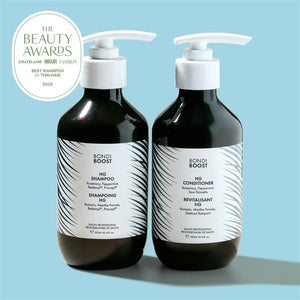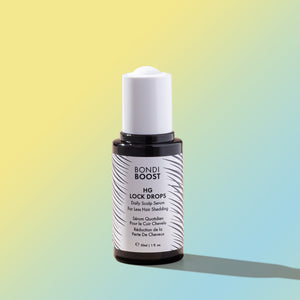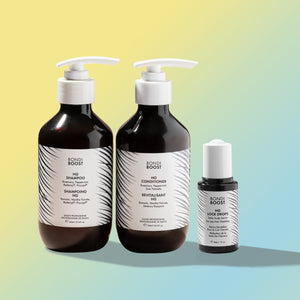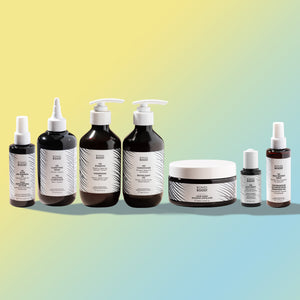What Is Hair Porosity? The Haircare Hack That Could Transform Your Routine
Yes, You Should Be Building Your Routine Around Your Hair’s Porosity Level
It’s super easy to figure out yours, too.
You’ve heard about hair types, but what about hair porosity? Understanding where your strands fit on the porosity scale could be the key to unlocking your best hair yet. See, hair porosity plays a major role in how your lengths absorb and retain moisture – key stuff for getting that longer, stronger hair of your dreams.
It’s easy to figure out which type you have, and once you know, you can pick the right products so your hair has everything it needs to stay in top shape.

What is Hair Porosity?
So, hair is kinda like a sponge. Your strands soak up and hold onto moisture, oils, and other treatments – but how they take these in varies from person to person. It all comes down to how your hair’s cuticle (the outer layer of each strand) is structured.
There are three main categories of hair porosity: low, medium, and high.
Low Porosity
If you have low porosity hair, your cuticles are tightly packed together and create a super-smooth surface. That’s good news for resisting damage, and you probably find your hair is pretty strong. But it’s bad news for moisture absorption. Your hair is borderline waterproof — it’s tough for hydrating products to penetrate that hair shaft.
Signs of low porosity hair:
- It takes forever to get wet or dry.
- Products sit on top of your hair instead of absorbing.
- You’re prone to product buildup, leaving your hair feeling greasy or weighed down.
Medium Porosity
Medium porosity hair is when the cuticle layers are looser than low porosity hair but not as wide open as high porosity. It’s a happy medium! Your hair soaks up moisture and treatments without going overboard and usually has good elasticity and shine.
Signs of medium porosity hair:
- It’s pretty low maintenance.
- It holds styles well and responds nicely to products.
- It’s shiny, soft, and dries in a reasonable amount of time.
High Porosity
Oof! Your hair is thirsty! High porosity hair has a cuticle that’s way more open, so it absorbs moisture easily - probably a little too easily! It also, unfortunately, loses that moisture fast – hello, frizz, dryness, and damage.
Signs of high porosity hair:
- It dries super quickly, even when it’s drenched.
- Frizz and breakage are always hanging around.
- It might feel rough or look dull.
How To Figure Out Your Hair Porosity
Great news - you don’t have to visit an expert to determine your hair porosity level. You just need to do a basic school science test. Grab a strand of clean, dry hair and a glass of water. Drop the strand in gently, and watch what happens.
Floats to the top: Low porosity hair.
Sinks slowly to the middle: Medium porosity hair.
Sinks quickly to the bottom: High porosity hair.

So, What Now?
Now that you’ve figured out your hair’s porosity, let’s talk about routines. Here’s our cheat sheet to keep your hair looking its best, no matter where it falls on the porosity spectrum.
Low Porosity Hair
Since low-porosity hair has a tough time absorbing moisture, you want to focus on products that won’t just sit on the surface. Look for lightweight, water-based products and avoid heavy creams or oils that can lead to buildup.
Use the HG Rinse to really eliminate product buildup before shampooing, then go with our Heavenly Hydration Shampoo for a dose of lightweight moisture. Alternate between the Heavenly Hydration Conditioner and, for days when you need a little more nourishment, our Miracle Mask. Finally, never forget the Heat Protect Spray when styling!
Medium Porosity Hair
Medium porosity hair is pretty low-maintenance, so you can play around with a range of products without worrying.
Go with our OG, the HG Shampoo, for a great cleanse and scalp-loving ingredients to encourage hair health. Next, pick a restorative conditioner like our Rapid Repair Bond Builder+ Conditioner or Heavenly Hydration Conditioner. Deep-treat your strands with a lush mask, such as our Miracle Mask, once a week.
High Porosity Hair
You’ll need some extra help locking in nourishment, so the goal for your routine is to fill in those cuticle gaps with rich, moisture-sealing products.
Anti-frizz products and your hair are the best pals, so we recommend starting with our Anti-Frizz Smoothing Shampoo. Follow up with a hair mask – your strands can take the regular moisture! The new Rapid Repair Bond Builder+ Leave-In Hair Mask is a great choice for restoring all those broken lengths and giving long-term nourishment. Keep frizz at bay with prep products, like our Frizz Fix Serum or Rapid Repair Bond Builder+ Finishing Oil.













